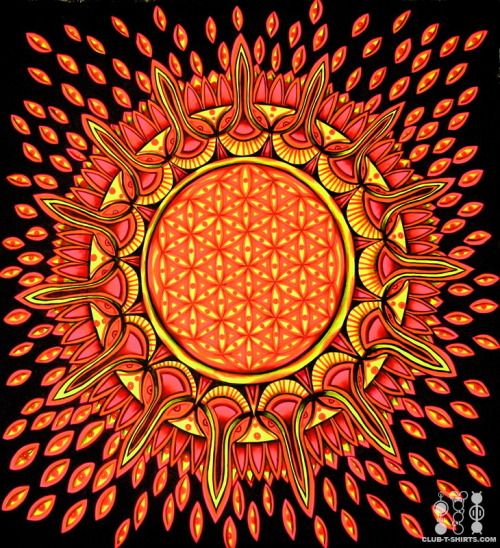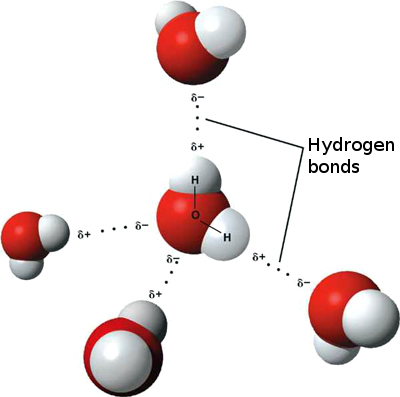

Friday, October 28, 2011
Thursday, October 6, 2011
Aboriginal sundial could be 10,000 years old

 (BBC Audio)
(BBC Audio)
http://www.bbc.co.uk/iplayer/episode/p00kdr09/Discovery_Aboriginal_Astronomy/
Dubbed Wurdi Youang, the strange stone arrangement was found on property near Mt Rothwell, 80km west of Melbourne - its two points set in perfect alignment with the setting sun on a midsummer's day.
CSIRO experts believe the ancient Aboriginal sundial could be upwards of 10,000 years old, an estimate that would have it pre-date the famous neolithic Stonehenge and the only remaining ancient wonder of the world, the Egyptian Pyramids.
Its location is a closely guarded secret.
CSIRO astro-physicist Professor Ray Norris said the precise alignment of the stones proved it was constructed to map the sun.
"This can't be done by guesswork, it required very careful measurements. If it goes back, let's say, 10,000 years, that predates the Egyptians, the Pyramids, Stonehenge, all that stuff," Professor Norris said.
Wurdi Youang is an egg-shaped ring of stones about 50 meters across. Some of the stones have significant astronomical alignments. For example, some stones seem to indicate the position of the setting sun at the equinoxes and solstices, although there is some disagreement over this idea. Like Stonehenge in the U.K., no records of its use survive, and consequently, nobody knows what it was used for.
http://www.news.com.au/technology/sci-tech/ancient-aboriginal-eyes-were-on-the-skies/story-fn5fsgyc-1226000523978
Read more:
http://arxiv.org/abs/0906.0155
Sunday, September 4, 2011
Abracadabra
Biblical scholar John Allegro, author of THE SACRED MUSHROOM AND THE CROSS
"Our father who art in heaven". Father = Abba. Abba comes from Ab-ba-tab-ba-ri-gi, the Sumerian name for mushroom. If you see a similarity with the klitche magicians incantation, Abracadabra, you would be correct.
"Give us this day our daily bread" is probably not a correct interpretation either (according to Allegro). Allegro thinks it means "that which is needful, give now bread. "bread" however is mushroom encrypted. For the Gnostics/Essences these things were encrypted, and not shared with the general public.
Allegro believes that Christ was the embodiment of the sacred mushroom spirit. To eat the body of Christ is to eat the sacred mushroom.
http://en.wikipedia.org/wiki/Abracadabra
Historically abracadabra was believed to have healing powers when inscribed on an amulet.
abra (אברא) means "to create" and cadabra (כדברא) which means "as I say"
The first known mention of the word was in the second century AD in a book called Liber Medicinalis (sometimes known as De Medicina Praecepta Saluberrima) by Quintus Serenus Sammonicus,[1] physician to the Roman emperor Caracalla, who prescribed that malaria[2] sufferers wear an amulet containing the word written in the form of a triangle:
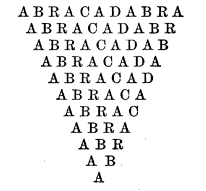
This, he explained, diminishes the hold over the patient of the spirit of the disease.Other Roman emperors, including Geta and Alexander Severus, were followers of the medical teachings of Serenus Sammonicus and may have used the incantation as well.
It was used as a magical formula by the Gnostics of the sect of Basilides in invoking the aid of beneficent spirits against disease and misfortune.[4] It is found on Abraxas stones which were worn as amulets. Subsequently, its use spread beyond the Gnostics.
Friday, July 8, 2011
Tuesday, June 28, 2011
The Emerald Tablets of Thoth
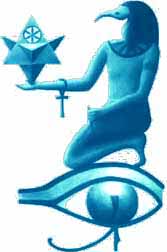
Raised I to LIGHT, the children of KHEM. Deep 'neath the rocks, I buried my spaceship, waiting the time when man might be free.
Over the spaceship,
erected a marker in the form
of a lion yet like unto man.
There 'neath the image rests yet my spaceship,
forth to be brought when need shall arise.
Know ye, O man, that far in the future,
invaders shall come from out of the deep.
Then awake, ye who have wisdom.
Bring forth my ship and conquer with ease.
Deep 'neath the image lies my secret.
Search and find in the pyramid I built.
Each to the other is the Keystone;
each the gateway that leads into LIFE.
Follow the KEY I leave behind me.
Seek and the doorway to LIFE shall be thine.
Seek thou in my pyramid,
deep in the passage that ends in a wall.
Use thou the KEY of the SEVEN,
and open to thee the pathway will fall.
Now unto thee I have given my wisdom.
Now unto thee I have given my way.
Follow the pathway.
Solve thou my secrets.
Unto thee I have shown the way.
THREE holds the key of all hidden magic,
creator he of the halls of the Dead;
sending forth power, shrouding with darkness,
binding the souls of the children of men;
sending the darkness, binding the soul force;
director of negative to the children of men.
FOUR is he who looses the power.
Lord, he, of Life to the children of men.
Light is his body, flame is his countenance;
freer of souls to the children of men.
FIVE is the master, the Lord of all magic -
Key to The Word that resounds among men.
SIX is the Lord of Light, the hidden pathway, path of the souls of the children of men.
SEVEN is he who is Lord of the vastness, master of Space and the key of the Times.
EIGHT is he who orders the progress; weighs and balances the journey of men.
NINE is the father, vast he of countenance, forming and changing from out of the formless.
Meditate on the symbols I give thee.
Keys are they, though hidden from men.
Reach ever upward, O Soul of the morning.
Turn thy thoughts upward to Light and to Life.
Find in the keys of the numbers I bring thee,
light on the pathway from life unto life.
Seek ye with wisdom. Turn thy thoughts inward. Close not thy mind to the flower of Light.
Place in thy body a thought-formed picture.
Think of the numbers that lead thee to Life.
Clear is the pathway to he who has wisdom.
Open the door to the Kingdom of Light.
Pour forth thy flame as a Sun of the morning.
Shut out the darkness and live in the day.
Take thee, O man! As part of thy being,
the Seven who are but are not as they seem.
Opened, O man! Have I my wisdom.
Follow the path in the way I have led.
http://www.crystalinks.com/emerald.html
Jinn (Genie)
Jinn

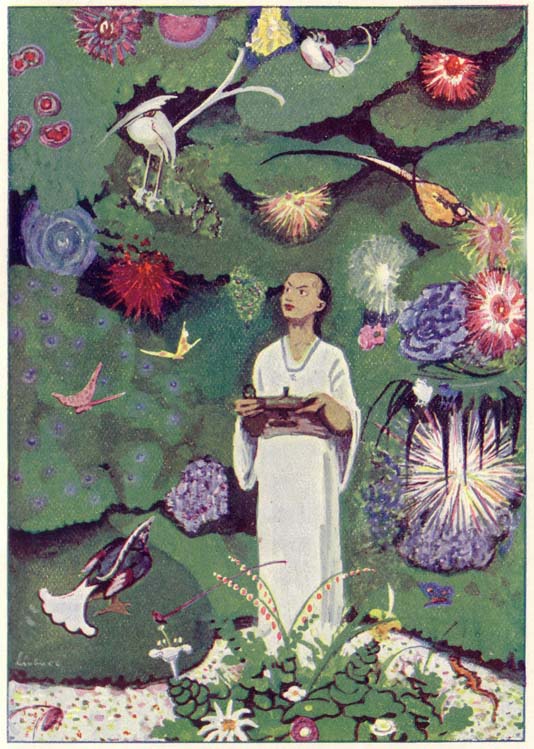
jinn (Arabic: جن jinn, singular جني jinnī; variant spelling djinn) or genies are supernatural creatures in Arab folklore and Islamic teachings which occupy a parallel world to that of mankind. Together, jinn, humans and angels make up the three sentient creations of Allah. According to the Qur’ān, there are two creations that have free will[citation needed]: humans and jinn. Religious sources say barely anything about them; however, the Qur’an mentions that jinn are made of smokeless flame or "scorching fire".[1] Like human beings, the jinn can also be good, evil, or neutrally benevolent.[2]
The jinn are mentioned frequently in the Qur’an, and there is a surah entitled Sūrat al-Jinn in the Quran.
The Arabic root j-n-n means 'to hide, conceal'. A word for garden or Paradise, جنّة jannah, is a cognate of the Hebrew word גן gan 'garden', derived from the same Semitic root. In arid climates, gardens have to be protected against desertification by walls; this is the same concept as in the word paradise from pairi-daêza, an Avestan word for garden that literally means 'having walls built around'. Thus the protection of a garden behind walls implies its being hidden from the outside. Arabic lexicons such as Edward William Lane's Arabic-English Lexicon define jinn not only as spirits, but also anything concealed through time, status, and even physical darkness.[4] .
The word genie in English is derived from Latin genius, which meant a sort of tutelary or guardian spirit thought to be assigned to each person at their birth. English borrowed the French descendant of this word, génie; its earliest written attestation in English, in 1655, is a plural spelled "genyes." The French translators of The Book of One Thousand and One Nights used génie as a translation of jinnī because it was similar to the Arabic word in sound and in meaning. This use was also adopted in English and has since become dominant.
Jinn in the pre-Islamic era
Types of jinn include the shayṭān, the ghūl, the marīd, the ‘ifrīt, and the jinn. According to the information in the Arabian Nights, ‘ifrits seem to be the strongest form of jinn, followed by marids, and then the rest of the jinn forms.
A few traditions (hadith), divide jinn into three classes: those who have wings and fly in the air, those who resemble snakes and dogs, and those who travel about ceaselessly.[12] Other reports claim that ‘Abd Allāh ibn Mas‘ūd (d. 652), who was accompanying Muhammad when the jinn came to hear his recitation of the Qur’an, described them as creatures of different forms; some resembling vultures and snakes, others tall men in white garb.[13] They may even appear as dragons, onagers, or a number of other animals
Relationship of King Solomon and the genies
According to traditions, the jinn stood behind the learned humans in Solomon's court, who in turn, sat behind the prophets. The jinn remained in the service of Solomon, who had placed them in bondage, and had ordered them to perform a number of tasks.
"...and there were jinn that worked in front of him, by the leave of his Lord," (Qur’an 13:12)
"And before Solomon were marshalled his hosts,- of jinn and men and birds, and they were all kept in order and ranks." (Quran 27:17)
The Qur’an relates that Solomon died while he was leaning on his staff. As he remained upright, propped on his staff, the jinn thought he was still alive and supervising them, so they continued to work. They realized the truth only when God sent a creature to crawl out of the ground and gnaw at Solomon's staff until his body collapsed. The Qur’an then comments that if they had known the unseen, they would not have stayed in the humiliating torment of being enslaved.
"Then, when We decreed (Solomon's) death, nothing showed them his death except a little worm of the earth, which kept (slowly) gnawing away at his staff: so when he fell down, the jinn saw plainly that if they had known the unseen, they would not have tarried in the humiliating Penalty (of their Task)." Qur’an 34:14)
http://en.wikipedia.org/wiki/Jinn
Venus Transit 6 June 2012
Visualisation of how Venus' orbit interacts with Earths
http://gunn.co.nz/astrotour/?data=tours/retrograde.xml
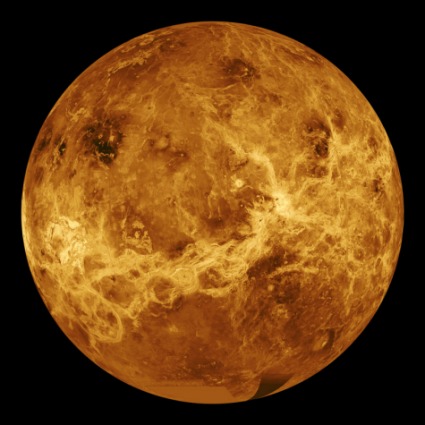
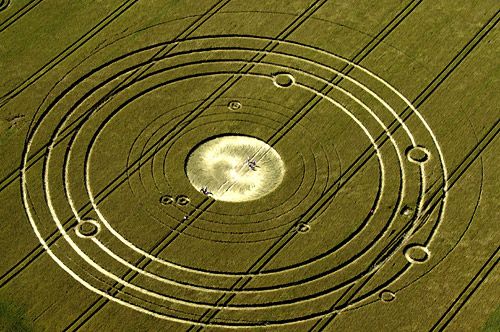



Flying Ointment - Witches
 Flying ointment, also known as witches' flying ointment, green ointment, magic salve and lycanthropic ointment, is a hallucinogenic ointment said to be used by witches in the Early Modern period (first described by Johannes Hartlieb in 1456)
Flying ointment, also known as witches' flying ointment, green ointment, magic salve and lycanthropic ointment, is a hallucinogenic ointment said to be used by witches in the Early Modern period (first described by Johannes Hartlieb in 1456)
The generally accepted theory about the origins of witches and flying with their brooms is based in a ritual involving a psychoactive drug trip.[1] The witches would prepare a flying ointment to aid them in their journey. There are many recipes for this ointment all having a base of either Atropa belladonna or Mandragora officinarum, both highly psychoactive drugs producing visions and encouraging astral projection.[2] The ointment was rubbed all over the body using the broom. A personal account is given by one witch who described the act of rubbing the ointment on her hands and feet, which provided a sensation of flying. Witches mounted broomsticks and would leap around the fields, smeared with the flying ointment, in order to "teach the crops how high to grow". The ointment would give them hallucinations, which made them believe that they flew distances.[3]
It was said that witches were able to fly to the Sabbath on their brooms with help of the ointment. Likely the riding of the broom has a different origin.
It was happening simply as part of the practice of women and men wise in the rural magic arts and healing based on arcane plant knowledge. The people who became identified as “witches” by the Church were in actuality simply the continuation of an ancient tradition of “night travellers.” In northern Europe they were called qveldriga, “night rider,” or myrkrida, “rider in the dark.” In Scandinavia, there was the tradition of seidhr, in which a prophetess or seidhonka would travel around farmsteads and hamlets with a group of girls to give divinatory trance-sessions. She wore a ritual costume and carried a staff. The goddess Freya, who taught Odin the secrets of magical flight, was the patronal mistress of seidhr. “Night travellers and the later witches are carelessly lumped together,” Hans Peter Duerr warns.
The real boundary was that between the conscious, waking mind – “civilisation” – and the dark, fearsome and unknown regions of the unconscious – “wilderness.” It was simply literalised and projected onto the physical environment. In reality, the night-traveller’s flight into the wilderness was a trance “journey” into the deep reaches of the unconscious mind, a “spirit flight” caused, usually, by hallucinogens in the flying ointments.
The night-riders and “witches” often thought of themselves as flying animals – owls, farmyard beasts, and, quite often, wolves. Harner has commented that perhaps the ancient and widespread European belief concerning humans turning into wolves – lycanthropy – resulted from hallucinogenic experience, and suggests that the inclusion of animal fat, blood and body parts in witches’ ointments may have been for the purposes of creating the suggestion of becoming an animal.
http://www.dailygrail.com/features/witches-brews
Thursday, May 12, 2011
Cymatics - Flower of Life
“Single freq.(14hz),special mixture liquid in water distillate.” - YouTube user “kelemengabi”
/Fury 888
Thursday, April 28, 2011
The Geometry of Snowflakes - Oxygen Structure
Diagram of binding energy distribution between the electrons in the oxygen molecule
http://www.guns.connect.fi/innoplaza/energy/story/Kanarev/ozone/index.html
http://www.dailykos.com/story/2009/11/15/804812/-The-Geometry-of-SnowflakesOxygen-Structure
Like the 120 degree angle formed regularly in snowflakes, liquid or gaseous water has a consistent angular formation. With the hydrogen atoms always sharing two sets of two electrons on one side of the Oxgen nucleus. And the two Hydrogen nuclei always forming an angle of about 104.4 degrees with each other.
As I mentioned before, The geometry of the various angles in which the elements arrange themselves is not yet fully understood. There are theories about how the angles result from the attractive and repulsive forces of the electrons in atoms. But they don't work consistently across different elements. But we do have descriptions of what the angles are for most elements. And we know which elements can combine with each other. As well as the angles that form between them when they do. But we haven't understood in a convincing way, why the elements form the angles that they do. We don't have anything that explains the source of the geometry. We just know what the geometry is.
Below is a model of nuclear formation that goes beyond the current one. A model that describes the three dimensional configuration of protons and neutrons in a nucleus -- and accounts for the resulting geometry of atomic bonds that science has already determined. Oxygen is just one example of an element that this model explains the geometry of, more convincingly than the current model. I'll give a brief description of the model, then focus on the resulting configuration for Oxygen, which determines the known bonding angles that form in both water and snowflakes.
In this model, protons and neutrons are composed of different numbers of the same elements -- called Hawkrings. There are two types of Hawkrings. Left(positive) rings and right(negative) rings. A neutron consists of 4 left Hawkrings and 4 right Hawkrings, joined together in an alternating chain of 8 rings. The chain joins end to end forming a circle of 8 rings. The rings are bound together by gluons. Below is a picture of a neutron in its natural state, a circle. The shape it forms, if it's not attached to another hadron. I'll use the term hadron here to refer to either protons or neutrons, or both -- though this term generally refers to anything inside a nucleus.

A proton is formed from the same configuration as a neutron, except that an additional left ring joins the formation in the center, bonding to the 4 right rings in the outer ring. This gives a proton a square shape, pictured below.
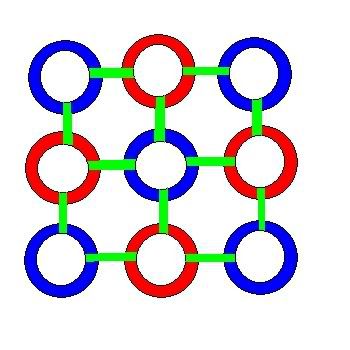
Neutrons are more flexible than protons. They can assume the square shape of a proton, when they are bound to other hadrons, or they can accommodate themselves to other shapes. In the spherical configuration of an Oxygen nucleus, neutrons do both of these things. A squared proton is below.

In the formation of the elements, individual Hawkrings in protons and neutrons become bonded to rings in other hadrons. By gluons, that join these building blocks together in certain shapes. The four Elements following Hydrogen, Helium(2), Lithium(3), Beryllium(4), and Boron(5), all have box-like shapes. But the next 5, Carbon(6), Oxygen(8), Nitrogen(9), Fluorine(10) and Neon(11) are all spheres. Carbon is built on a six-sided ring, with 6 more hadrons filling out the top and bottom. And the others all built on a similar eight-sided ring, with differing numbers of protons and neutrons above and below, according to their atomic number.
The formation of an Oxygen nucleus is pictured below. First an alternating ring of 4 protons and 4 neutrons forms a ring. On top, two protons attach to two opposing neutrons in the ring. Then two neutrons attach to the ring and to the corners of the protons. Tying the top together. And leaving the two protons facing up at almost exactly 45 degrees from horizontal. Perhaps a little bit higher than that because the neutrons are not attached to the ring as symmetrically as the protons. The bottom is the same configuration, but rotated 90 degrees relative to the top.
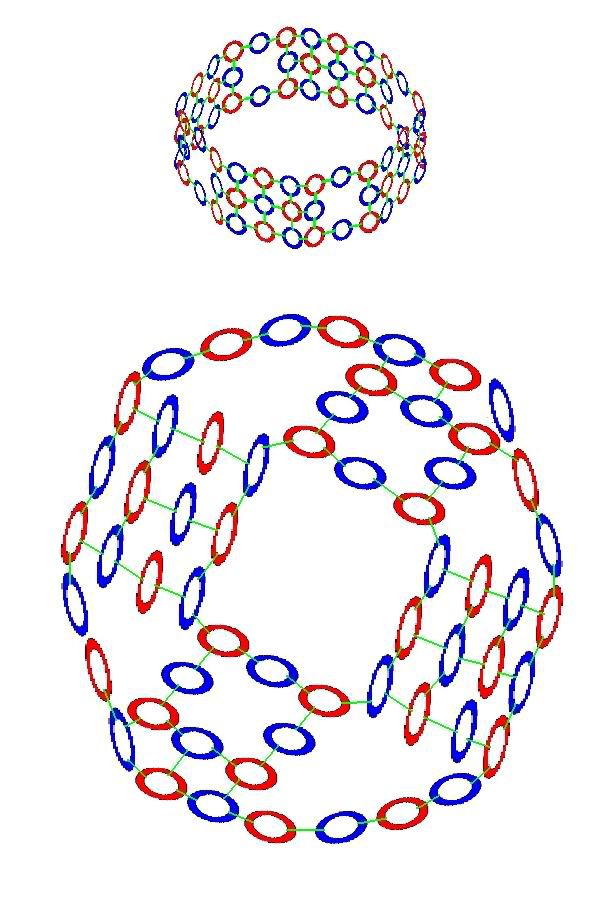
Oxygen(8) is the most perfectly symmetrical of all the spheres. And it's easy to see how the geometry of the Oxygen nucleus creates the amazing properties of water. The location of the proton faces in a nucleus determines where an element's electrons will be arranged. In Oxygen, The 8-ring of alternating protons and neutrons means, if you were standing in the center of the nucleus, directly in front, behind and to your right and left, there would be a proton, and an electron extending directly out from each of those. Above, would be two more protons and electrons. If you turn 45 degrees left and raise your arms up 45 degrees above horizontal, that's where the two top electrons will be. Same for the bottom, but you'd rotate 45 degrees right from your original position. So the top and bottom proton faces are oriented at 90 degrees to one another. The angles formed by these eight lines fit perfectly with what science has determined about the bonding angles in water and in snowflakes.
Below is a simplified picture of an Oxygen atom. Protons and neutrons are represented as either a red(neutron) or blue(proton) square. On the top and bottom, only the protons are shown. Extending from each proton is a line representing the direction of the proton's electron. With each line, is a small x, y, x axis to show the direction of the electron toward the nucleus. Either toward you or away from you. On the number 1 electron, the z axis arrow is pointing down, toward you. The numbering scheme is present to designate each electron so it can be easily identified in discussing the angles that form around the Oxygen nucleus.
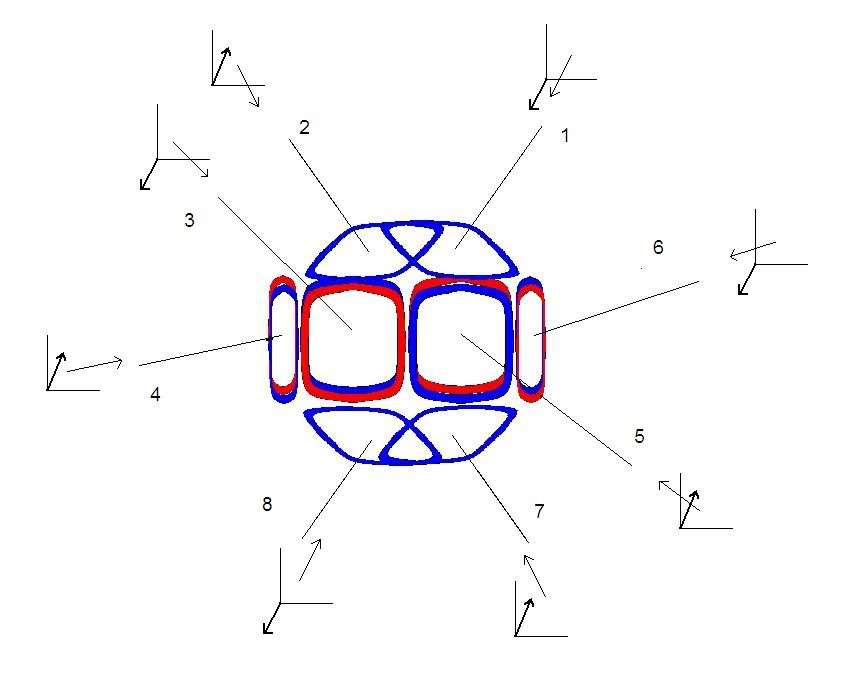
The next image is a simplified picture of a water molecule. The two single blue squares are Hydrogen nuclei -- single protons. Each shares two electrons with the Oxygen atom in covalent bonds. The electrons are single negative Hawkrings. One bonded to the 1 and 3 electrons. The other to the 2 and 4 electrons.
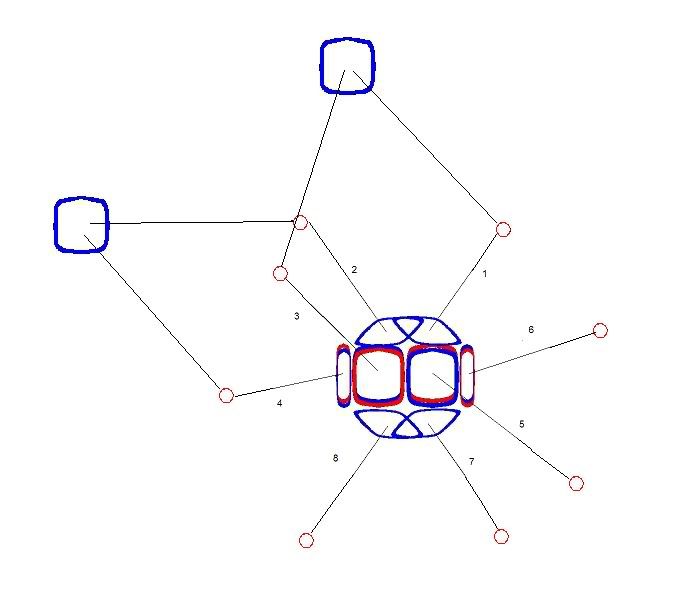
In liquid or gas form, an Oxygen atom shares two sets of its eight electrons with two hydrogen nuclei in covalent bonds. Where each Hydrogen nucleus shares two electrons with the Oxygen nucleus. These two bonds form the well known angle between the two hydrogen atoms in a water molecule, which is about 104.4 degrees. The natural angle between the 1, 3 covalent bond and the 2, 4 covalent bond, if the formation was perfect, would be 105 degrees. But as described earlier, the angle is very slightly changed due to the imperfect neutron formation on the top and bottom of the Oxygen nucleus.
So, the covalent bonds between Oxygen and Hydrogen in liquid water give water molecules the shape seen above, which makes the molecule electrically polar. The leads to the formation of what is called the Hydrogen bond. Causing water molecules to stick to each other. The Hydrogen end of the molecule is electrically positive and the two Hydrogen nuclei form a wedge at 104.5 degrees. When this wedge is near another water molecule, it is attracted to the negative end of the other molecule, the end on the opposite side of that molecule's Hydrogen end. The positively charged wedge shares electric energy with the electrons on the negative side of the other water molecule when the molecules come into contact. The Hydrogen bond is more easily broken and reformed than the covalent bonds that hold each molecule together. This allows liquid water molecules to move around each other easily, yet they are still strongly attracted or bound to each other.
Now I'lll describe the formation of snowflake crystals. And here I'll depart slightly from the way our science describes this formation. As far as I've been able to understand the current thinking on this formation, the bonds between water molecules in snowflakes, remain as they are in liquid water, they just become more static. That is, the covalent bonds in individual molecules remain intact. As do the Hydrogen bonds with other molecules. The only difference is that the molecules become arranged in a hexagonal pattern and stay locked in it while the snowflake is frozen. But I can't find any explanation of why these bonds form the 120 degree angle required for the snowflake crystal formation. If anyone reading does understand the reasoning behind this, I'd appreciate hearing about it in comments.
In my model, the bonds between molecules change as water turns to ice. Instead of a mixture between covalent and Hydrogen bonds, All the bonds are converted to univalent bonds. Where only one electron is shared between each Oxygen and Hydrogen nucleus. Just like in the liquid formation, each Oxygen nucleus bonds with Hydrogen nuclei among 4 of its electrons. But, two of the covalent bonds in the liquid formation become univalent with one of the electrons it was bound to as a liquid. And two new univalent bonds are formed with two other freezing molecules.
Let's look at a picture to see how this would happen. Below are a few water molecules in the liquid state.
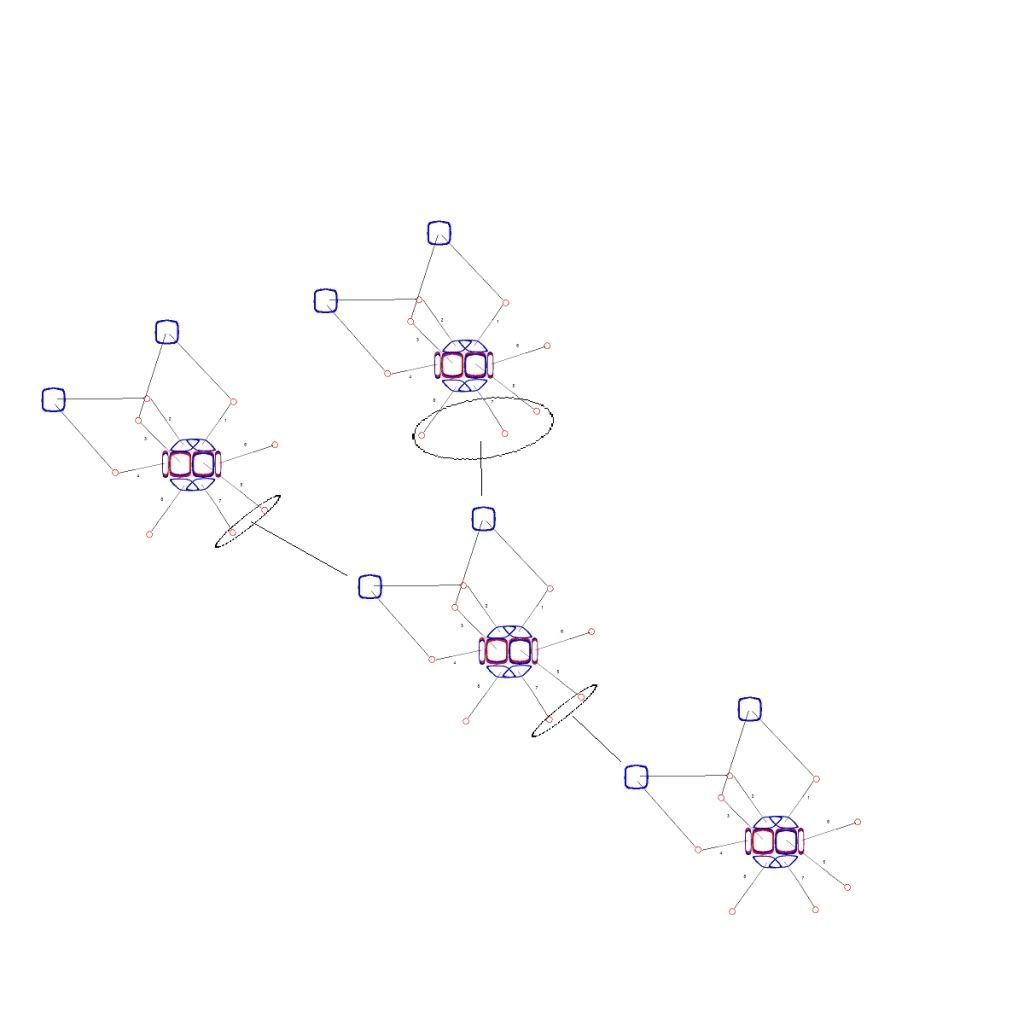
All the Oxygen nuclei are covalently bonded to their two Hydrogen nuclei. The upper two molecules are Hydrogen bonded to the middle molecule. The middle and lower molecules are also Hydrogen bonded. The covalent bonds are between the 1, 3 electrons and the 2, 4 electrons for all the molecules. As the molecules freeze, the 1, 3 bond in the middle molecule becomes univalent with the upper one. Now it is bound to that molecule with just the number 1 electron. The 2, 4 bond is similarly reduced to the number 4 electron, which opposes the number 1 electron at 120 degrees. The number 7 electron's Hydrogen bond also becomes univalent. The 7 electron opposes both the 1 and 4 electrons at 120 degrees -- they are all in one plane, dividing 360 degrees into 3 120 degree angles -- this is the source of the hexagonal snowflake formation. The number 7 electron had been Hydrogen bonded to the middle molecule. Now that bond becomes univalent with the number 7 electron and we have 3 Oxygen molecules rigidly bound in a plane at 120 degrees to each other. One more univalent bond forms in the middle molecule, with either the 3 or 5 electron. This bond is not at 120 degrees to any of the other bonded electrons. It is at roughly 80 degrees to the plane those electrons are in. This bond is what connects the layers of hexagonal formations in the snowflake structure.
In a single hexagonal snowflake ring, each of the six molecules will have two electrons bonded to two others in the ring. And they will have one more electron bonded to other molecules forming other hexagons in the same plane. Each of the six will also have one more bond to a molecule in a ring above or below it. Three of the six will be bonded above and 3 will be bonded below. The up or down orientation of these bonds in a single ring alternates as you go around the ring. This crystal snowflake lattice formation results from the nearly perfect symmetrical geometry of the Oxygen nucleus.
In regular ice, like you have in your freezer -- hexagonal type 1, the formation of water molecules is not as open as in snow. It's more tightly packed, as if you folded a flat hexagon in a weird way. And joined those together in a tighter formation. This structure is more dense and stronger than a snowflake structure. It's strength comes from a simple, sound architectural formation, based on the angles of the Oxygen nucleus. It also comes from the change to univalent bonds that occurs when water freezes. When these bonds are formed, water molecules are pushed out of the way so the structure has room to form. And the crystalized structure of all ice is more open than the arrangement of liquid water. This is why water has the unusual property of expanding by about 10 percent when it freezes. This increase in the volume of water begins to take place when the temperature of water drops below 4 degrees Celsius. And is complete at 0 degrees. As this bond shifting occurs, the volume of water increases as the bonded molecules become rigidly locked in crystal formations.
In snowflake crystals, the Hydrogens are bonded to the number 1 and 4 electrons. These two are at almost exactly 120 degrees from each other. and the number 7 electron opposes both of those at the same angle. This electron becomes the focus of another bond. This results in the hexagonal lattice structure in snowflakes, pictured below. Some of the Oxygen nuclei are turned upside down to make the angles come out right. And all the bonds are shown as single covalent bonds between oxygen atoms for simplicity. In an actual snowflake hexagon, Hydrogen atoms would be between the bonds. The purpose of this diagram is to show that the angles in an Oxygen nucleus are the source of the hexagonal lattice crystal structure in snowflakes.

These hexagon structures also form layers one on top of the other. If you connected another water molecule to the number 5 electron in the leftmost Oxygen nucleus above, and also every alternating nucleus in the circle, they would all join to form another hexagon behind this one. Same thing with the number 5 electron beginning a formation of another hexagon in front of this one.
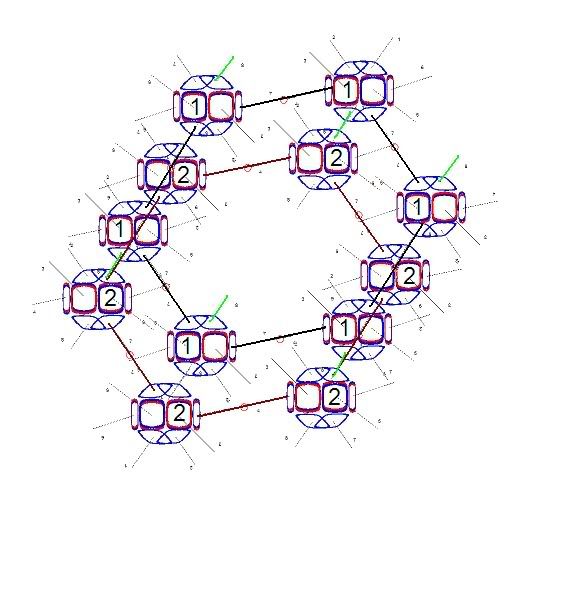
This idea is also picture below in a diagram borrowed from a website at the following Url. http://www.cs.unm.edu/...
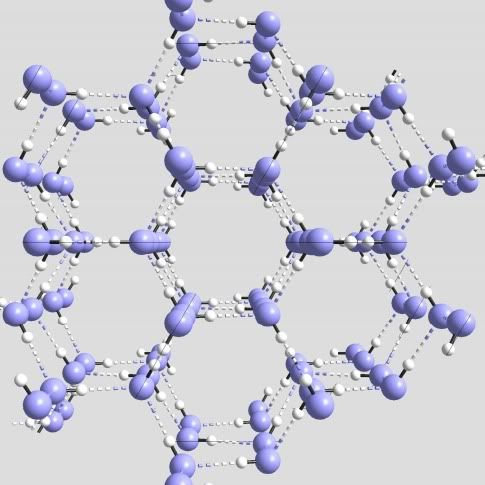
And here is a picture of a dendrite snowflake, borrowed from: http://www.its.caltech.edu/...
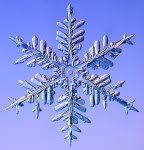
In the model I've begun to describe here, each element has a specific three dimensional configuration that produces the arrangement of electrons around its nucleus. The arrangement of the electrons and their bonding tendencies and angles are easily seen in the nuclear configurations. And of the 20 or so elements I have figured out so far, the properties all match with those already determined by science. Other effects, such as magnetism, electric and thermal conductivity and density are also explained by the configurations.
I'm currently working out the angles and bonds in the other organic elements: Carbon, Nitrogen, Phosphorus and Sulfur. I plan to have another diary up soon describing the bonds in some organic molecules, including DNA.
I also have several diaries describing the whole theory behind this nuclear model. Including a more thorough description of the mechanics of the nuclear aspect of it. Anyone interested can find them by searching for diaries by Sneelock, or the tags: Einstein, Physics, Chemistry and Science. I would recommend reading them in the following order.
Relativity
New Science
On the Machinery of Motion
Feynman Force
http://sjsu.rudyrucker.com/...






















